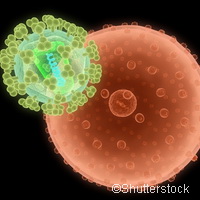ERC-funded scientists develop sophisticated HIV detection test
Two researchers funded by the EU have succeeded in developing and testing a state-of-the-art HIV detection test. The Imperial College London, United Kingdom duo says the test is 10 times more sensitive than other methods used to identify this disease, and it is inexpensive. The potential to bring this innovative technique to market is strong, providing a way to diagnose HIV earlier. The findings were published in the journal Nature Materials. Professor Molly Stevens and Dr Roberto de la Rica, who received a EUR 1.6 million European Research Council (ERC) Starting Grant and a EUR 212,000 Intra-European, Marie Curie Actions fellowship, respectively, looked for an HIV protein, a molecule named antigen p24, which scientists used to detect HIV in newborns with a relative degree of success. Their latest findings are miles ahead of what other studies discovered in the past because of the nanotechnology techniques developed and used in their tests. Professor Stevens and Dr de la Rica evaluated 30 blood samples donated by St Mary's Hospital in London and detected the disease in 10 patients; this would not have been possible if traditional techniques had been used. 'Using current technology to look for early signs of a virus or a disease can be like finding the proverbial needle in a haystack,' said Professor Stevens. 'Our new detection system, is highly innovative; it is not only an affordable methodology that will greatly improve the standard of living of patients with HIV infection in low income countries, but as it is also more sensitive than any existing conventional test, it will also enable the ultrasensitive detection of disease biomarkers, i.e. biological indicators of disease, with the naked eye.' Commenting on the groundbreaking result, Dr de la Rica said: 'We have abandoned principles within the existing methodological framework to propose a radically new line of investigation. The test will allow us to detect HIV infection in patients that were previously undetectable, and costs will be significantly cheaper.' The researchers believe the novel test could prove beneficial for laboratories that do not have many resources. They said numerical analysis would not have to be performed to count the number of viruses per collected blood sample to determine an HIV case. A change in the colour of the analysed samples would be enough to confirm or discard infections, according to them. Commercialisation of the test is possible if more research is conducted. But the researchers said they are hopeful that their research can be translated to the clinical setting and point-of-care use.For more information, please visit:European Research Council (ERC):http://erc.europa.euImperial College London:http://www.imperial.ac.ukNature Materials:http://www.nature.com/nmat/index.html
Countries
United Kingdom



